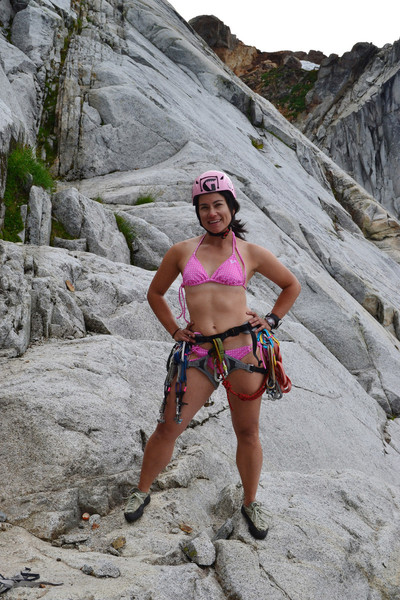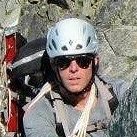-
Posts
4372 -
Joined
-
Last visited
-
Days Won
24
Content Type
Profiles
Forums
Events
Posts posted by DPS
-
-
When I climbed the route a few years ago we did it in 2 days and the 2nd day was a death march at the end. I recall the time breakdown being something like 12 hours camp to summit to camp, then 5 hours from camp to cars.
We had the same schedule. We left camp at the saddle at 4:30 AM and reached the car at 9:30PM. The hike out seemed to never end.
-
Hi,
Did you find a second tool necessary?
Thanks,
Dan
-
The supposed 4th/low 5th class after the notch on the North side is not nearly as exposed or stiff as some other reports may have indicated. In my opinion, the entire route goes at 4th class.
All of the climbing beyond 3rd class is completely secure, juggy, blocky, short, and not terribly exposed. Follow the Beckey beta and you'll be fine.
I would rate this routes technical climbing as easier and less sustained than that on the Tooth
That's an interesting perspective, thanks for sharing.
-
Congratulations on finishing nursing school! And nice TR. Most TRs on Triumph make it sound more casual than I found it to be. It seems a full Cascades meal deal with the approach, climbing on good Skagit Gneiss, and decent. We met Larry the guide a couple of weekends ago on SW Buttress of SEWS. He is a great guy with amazing beta and is well deserving of a shout out.
-
I'm interested in climbing Mt Rainier, either by the DC or Emmons by mid September. The weather forecasts suggest Sept 7-10 as the next possible weather window. I don't mind climbing with newer climbers, but I do want partners with ice axe, crampon, prusiking, anchor building, and z-haul skills. Please send a PM if you are interested and available for those dates.
Thanks,
DPS
-
I'm a big fan of 8.5 diameter ropes. That way I can use them for ice, rock, alpine or glacier travel and use a single rope on moderate routes. Likewise the 8.5s I've had have lasted a bit longer than my 8s. If you have money for a quiver of ropes a pair of 7.8s and a pair of 8.5s and a10-something for cragging is ideal... But if not go with the 8.5s.
I agree. I have double 8.5 (Edelweiss Everydry Sharps) that inspire confidence when using only a single strand and when climbing with a party of three with the followers on a single strand. I use 50 meter cords which work extremely well for alpine, unless the route has 60 meter raps established.
-
Weather forecast for Ashford is not super for Friday/Saturday. Looks much better for the following Monday/Tuesday.
-
One does have to hike up the Ingalls' Creek trail to get to the log crossing and up to long's pass after descending the Cascadian Couloir. I think the litmus test is if the descent sucks because it is steep and crappy and may have some rappels it is Ulrich's Couloir, if the descent sucks because it is loose scree and boulders it is the Cascadian, if it doesn't suck it is the ridge between Sherpa basin and Mount Stuart.
-
Hi,
Would that be gunsight peak in montana or idaho/nr priest lake?
thx.K
Prolly Gunsight Peak in the North Cascades, Washington State.
-
I think you summed up many of the important differences between alpine rock climbing and cragging very nicely.
-
I can't stress enough going in July. As Dan and others have said, June is really hit or miss around here, weather-wise, especially on Rainier. Meteorological summer (i.e., dry, stable wx) starts ~7/12 most years in the PNW and you would be best served if you changed your tickets to a later date. You don't want to go in August most years (too bony), mid July is usually the ticket for the easier routes.
+1. Good advice.
-
Reinhold Messner was standing at the col between NEWS and SEWS. Get it? He's Tyrolean.
-
Nice TR and photos. IMNSHO, Fisher Chimneys is the finest alpine route in the Cascades for its grade.
-
MVS,
Was that the video you and Aidan made of Fred? That is what I expected to see based on the link verbiage.
-
Add to that: long approach, climbing with a pack, cold hands, loose rock, wind, deteriorating weather...totally different experience than red pointing that 11a in the gym.
I'd like to be able to red point an 11a in the gym. Last time I was in a gym a girl asked me if I'd just started rock climbing.
-
You can get fuel at REI in Tacoma. I'm sure there are other stores such as Sports Authority/Joe's/Fred Meyer that carry fuel but I'm not sure which one would be on the way from SeaTac to Mt Rainier. I don't think you are technically allowed to sleep in the parking lot, you may want to make reservations at one of the camp grounds like Cougar Rock. There are plenty of motels/hotels around the airport, can't really recommend one over another. Or, instead of staying in a motel near the airport/sleeping in the parking lot, stay in one of the many cabins outside the park. The majority of climbers don't carry avalanche beacons in June. If you get hit by an avalanche it will likely be a wet slide on very steep ground and you'll probably be swept over the cleaver or into a crevasse and a beacon won't do you a whole lot of good. The weather in June is about 50/50. You may want to factor in a few weather days. I usually suggest having alternate plans should the weather be nuking on Rainier. Weather is often more favorable on the east side of the crest and mountains like Mt Stuart, Colchuck, Prusik, and Dragontail Peaks can be enjoying good weather.
-
As of last weekend (8/18) there were streams on the approach from Blue Lakes trail head to the spires, but that was fairly low down. There were a few small trickles running over slabs on the the approach to SEWS, but I didn't see anything you could really gather water from. I saw no snow patches under any of the Liberty group spires. If you are doing the link up of the spires you should not count on finding water on route.
-
Was looking to do the DC Friday and Saturday, but the forecast has evolved into something less than favorable. I've been monitoring the forecast vs telemetry data for Muir and there has been quite a bit of discrepancy. Just wondering, from those who have spent their time on the mountain, when you take the forecast for scripture and call it off. i.e. today the forecast called for 35mph avg wind at muir, but telemetry read 13avg.
The summit avg of 50mph is what's disheartening.
http://www.atmos.washington.edu/data/rainier_report.html
My only worry is waiting and rockfall/snow bridges becoming weaker and more prone to failure as the season starts wrapping up.
I appreciate the input
Generally speaking, weather fronts often hit Rainier before the outlying lowlands and the weather is typically more severe. If you don't get a shot this season, the mountain will still be there barring a catastrophic eruption.
-
I've got an idea of what I'll have on my very limited camp ALP 95 harness and I'll try and fit some stuff onto my backpack straps to act like gear loops.
You really shouldn't need to carry too much on your gear loops. Prusiks will be attached to the rope, pickets can be strapped to the side of the pack with the double length sling clipped over my shoulder to the pack's shoulder strap so you can just pull it off.
Harness loops can carry an ice screw, pulleys, a couple extra carabiners, a couple of alpine draws, a cordallete if that's your bag. Not much really else needs to go on there.
-
khu,
If you haven't read these already, I would recommend Andy Selter's book, Glacier Travel and Crevasse Rescue and Freedom of the Hills. Both have very good descriptions and illustrations of glacier travel rigs.
From the description of your set up it is not clear to me which method (there are several) you are following. It is not a bad idea to go out with a friend (ideally an experienced climber) to practice setting anchors, haul systems, ascending, etc. You can try the different systems and select the one that works best for you.
Crevasse rescue is pretty hard with a team of three, very difficult with just two, so you should be very well versed and practiced before heading out.
Gene makes a lot of good points. Rapping on 6 mm is tough, ascending would be even harder. I know a lot of climbers who like the weight of a skinny (i.e. twin or thin half) 30 m cord, but in practice a 50 m, slightly thicker cord has many advantages.
-
Sigh, it is hard, being old and haggard.

I'm not sure the photographic evidence supports this conclusion. You should submit more bikini photos and let the cc.com brain trust make that determination.
-
Now you're getting into sloppy travel which can make it more dangerous.
End of September is typically more boney than sloppy. Biggest problems include possible icy conditions, circuitous route finding, and exposed/loose rock. That said, I've enjoyed really fantastic conditions in mid September after a storm or two deposited snow which had consolidated into nice neve.
-
-
That may in fact be a Smiley, scroll down to the screws, one is listed as a Grivel (I have an identical one) and the other is listed as a Smiley. http://cascadeclimbers.com/forum/ubbthreads.php/topics/531766/



[TR] Triumph - NE Ridge 9/1/2013
in North Cascades
Posted · Edited by DPS
We pitched out the entire route, not really knowing any better, but down soloed much of the route. We had originally planned on biviing on the route but the saddle camp was so nice and we didn't think we'd find snow/water on route, so we elected to camp there. We decided if we were to climb the route again we would take three days and camp at the saddle again and hike out the next morning. And we would take two 50 meter ropes and bigger cams.